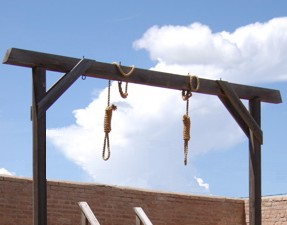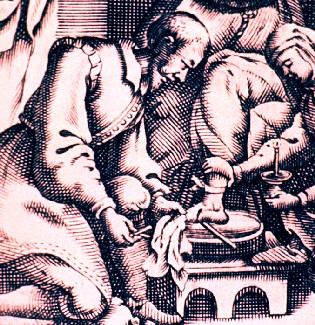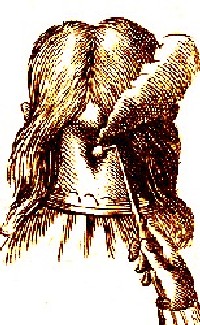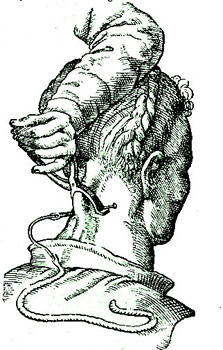
Headache Treatment Page Menu: 1 2 3 4 Next>>
Treating Headaches During the Golden Age of Piracy, Page 3
Headache Remedies

The Ultimate Headache Remedy - Hanging Halters
Many remedies were proposed during the golden age of piracy to treat headaches. Most of them involve humoral treatments, such as bleeding and the creation of issues, or medicines. A few are rather fantastic.
Amidst his more mundane suggestions, French surgeon Ambroise Paré suggests that a patient might try "The halter wherein one hath been hanged put about the temples, to help the head-ach."1 However the majority of the medical advice ran along the lines earlier suggested. Let's look at them.
1 Ambroise Paré, The Workes of that Famous Chirurgion Ambrose Parey, p.669
Headache Remedies - Bloodletting
A key facet of humor theory treatment was letting blood. Bleeding was widely recognized as a treatment for this malady. German military surgeon Matthias Gottfried Purmann noted that it was "well known even to the Vulgar, that Bleeding at the Nose, does take away or at least eases the Head-ach... for which reason all Men of sense esteem such Hæmorrhagia’s a great benefit of Nature."1 The most common method of surgeon-induced bleeding was to open a vein, often in the crook of the arm, similar to the way blood is drawn today. In headaches, however, other bleeding locations were generally advised. They primarily centered around veins in and near the head.

Artist: Daniel Chodowiecki
Bleeding a Child From the Jugular, from J. B.
Basedows' Elementarwerk (1774)
Sea surgeon John Atkins suggests opening the jugular vein for "violent Head-achs, or inflamed Throats; as fancying from being neared the Brain, a quicker and more immediate Relief may ensue."2 Atkins notes that the "common Method here, is making Ligature [tying a strand of material] round the Neck", but he commented that this is not wise for distempers of the brain.
He goes on to advise that "the neater way, is to let the Patient clap his Hand on the contrary side [of the throat], that stopping the Reflux in that Branch: this you are to open, may swell the better, and bear the Pressure of your Thumb, where the Ligature should have been; which steddies the Vessel [the jugular], to be opened secundum longitudinem [lengthwise]; thrusting (if it does not stream out,) the Porringer [dish for collecting blood] close instead of your Thumb, that the Blood does not dawb."3
Noted twelfth century Arabic surgeon Albucasis, whose material was still being taught in Europe during the golden age of piracy, advised opening "the two arteries in the temples" for severe headaches.4 He details his procedure,

Artist: Cintio d'Amato
Bloodletting from the Head, From Nuova et utlilssima
prattica di tutto quello ch'al diligente barbiero s'appartiene,
Opposite p. 40 (1671)
the patient should bind his neck with a sash [ligature] until the vessels stand out clearly to the eye and their pulsation is manifest under your finger; then mark with ink. Then with your forefinger raise the skin over the vessel and introduce a lancet beneath and lift up the vein and divide it ...and draw off as much blood as you need. Then loosen the band round the patient's neck and put your finger on the vein for a while; then apply cotton wool and a pad, bandage securely, and leave until it heals.5
Purmann details a case where he "opened the Temporal Artery on the left side...[for a man who was] troubled with a continual Head-ach above the Quarter of a Year together"6. This failed to work, so he applied leeches to bleed the patient and used a cauterizing agent called moxa, "which freed him from that Infirmity for about half a Year, but then it returned again."7
This led to a singular comment from Purmann that presaged the eventual downfall of bleeding as a treatment. "This Example I thought fit to recite in this Chapter, to shew, That this Operation is not always to be relied upon, tho’ some Men are pleased to extol it in the highest Degree, especially if there be any Malignity in the Case; for tho’ the Operation is as well performed as the Chirurgeon or Patient can define, yet it does not always answer Expectation; which I affirm from Experience and well-grounded Truth."8
Not all bloodletting focused on the area near the head, however. In reviewing the use of the procedure as a treatment for "great Pains of the Head", Purmann notes that Jessenius [Jan Jessenius, early 16th century physician] suggests "to open that Arterial Branch which lies between the Thumb and the Forefinger; but I think he will have much ado to find it, without injuring the adjoining Parts."9
In the

Artist: Cintio d'Amato
Bloodletting from the Foot, From Nuova et utlilssima
prattica di tutto quello ch'al diligente barbiero s'appartiene,
Opposite p. 40 (1671)
same review, Purmann says that Selingen (probably early 18th century surgeon Johannes Van Solingen) recommends opening "the Artery in the great Toe, and seems to be much in the right; for that Branch lies pretty high, is large, and there can be no Danger in doing it, because it may be well guarded and secured with Bandages."10
Atkins explains the logic of bleeding veins in the toes in his book. "Some chuse [to bleed] the Region opposite to the Complaint, and instance Head-achs and Diliriums, immoveable till bled in the Foot, alledging a contrary region also best for Revulsion"11.
Atkins notes that venesection "in the same Limb, or nigh [near] the Hurt, does probably increase the Fluxion [flow] in both Cases, ease succeeds better by a remote Derivation [bleeding a location distant from the head], and when it joins with the fancy [desire] of a Patient, or I could create that fancy, I would chuse a different Side, and an opposite Region."12
He used venesection of the foot when a Portuguese patient with a fever and headache failed to respond to emetics (medicines that would cause the patient to throw up.) Atkins explained that "at Night Fever and Head-ach would return with greater Violence, and break off in some lucid Interval again in the Mornings, at which Seasons of Remission, (chiefly) we bled them in the Foot three or four Times, perhaps in eight and forty Hours, according to the Humour and Practice of the Portuguese, who, as they presume themselves best Judges in the Country Distemper, build their Cure entirely on it, and repeat it much oftner."13
1 Matthias Gottfried Purmann, Churgia Curiosa, p. 328; 2,3 John Atkins, The Navy Surgeon, p. 191; 4,5 M.S. Spink, and G.L. Lewis, Albucasis On Surgery and Instruments; A Definitive Edition of the Arabic Text with English Translation and Commentary, p. 626-8; 6,7,8 Purmann, p. 14; 9,10 Purmann, p. 13; 11,12 Atkins, p. 189; 12 Atkins, p. 359-60
Headache Remedies - Issues/Fontanels
An issue made by a fontanel or seton is a wound created by the surgeon in a patient's skin to cause irritation. An issue produced suppuration - the formation of pus at the wound site. German military surgeon Matthias Gottfried Purmann explained that these were "commonly used against inveterate Defluxions of Rheum in the Eyes, and Pains in the Head; for by this means the peccant [offending] Humours are drawn away and evacuated."1 He goes on to give wonderful detail about the differences between setons and fontanels and how they were used.

Fontanel Created with Cautery Iron
From From L'Arcenal de Chirurgie by
Jacques Guillemeau, p. 156 (1597)
A fontanel can be made with a cautery iron with "the Skin touched with it, where you design to make the Fontanel, it will raise a blister, which being cut, and a Pea put into it, with a thin Piece of Silver upon the Pea, and Bolsters and a Bandage over the Silver Plate, to make the Pea work it's way downward; let it continue for two or three days, and at the next opening you will find the Issue made."2
Cautery irons are not the only way to open the skin. Purmann also suggested potential (chemical) cauterizing agents as well as "a small Pair of Pincers...with which they pinch a Hole in the Skin, big enough to put a Pea in."3 He also notes that the surgeon can use a white peppercorn in place of the pea.4 The pea is the irritation that causes the wound to issue pus.
Another way of creating an issue was by using setons. Purmann explains that "a Seton is much of the same Nature with a Fontanel only it has two Orifices which are made with a needle and a Skean [skein] of Silk on either side of the incision made where the seton, drawn through the fleshy Pannicle [membranous tissue] of the Neck, and is kept open by the Skean of Silk being drawn once or twice a day from one side to the other."5 The irritant here is the silk which is threaded through the skin with a large needle which is simply called a seton needle. The needle is drawn through the skin with the silk threaded through an eye at the back of it. The silk is left behind to be pulled back and forth as Purmann explained.
The image at right shows a tool being used to hold the skin bunched for insertion of the seton needle (which you will notice is quite thick) through the skin. Purmann's account does not mention this tool, simply noting that when performing this operation the surgeon, using

Artist: Marcus Severinus
Creating a Seton With Needle and Silk, From
Opera quae extant omnia, By William Fabry (1682)
the Fore-finger and Thumb of the Left-hand, they squeeze the Skin together and pluck it up as high as is necessary to sever the Skin from the Muscles: Then they thrust a great three-square Needle with a sharp Point and a little bended, through the flesh Pannicle, and draw the half Skean of Silk through the Skin, and there leave it; which being afterwards moistened with a Digest[ive Medicine] or Oyl of Roses, which must always be done at every Dressing; twice or thrice a day they draw the Silk from one side to the other, and the Business is done. Afterwards they dress it with Plaisters and Bolsters, as they do an Issue, as long as they desire to continue the Seton.6
Purmann only gives one example of actually using a fontanel for a merchant's wife who "was was continually troubled with an excessive Pain both in her Head and Teeth, which sometimes deprived her of the Use of her Senses."7 (This sounds remarkably like a migraine.) Purmann goes on to note that "the Issue I made was beneficial to her, that in a short time the Pain of her Head, and at length that of her Teeth went off as well as could be desired."8
The success of this operation notwithstanding, Purmann generally preferred to avoid using a seton or fontanel on a patient unless it seemed truly beneficial. "It is a very terrible and troublesome thing to be tormented with it, especially to tender Persons; but since it is no longer continued than there is urgent Necessity for it, and that in many Cases it's highly beneficial, several Persons are contented to endure it, in hopes that a Cure will recompence the Molestation."9
1 Matthias Gottfried Purmann, Churgia Curiosa, p. 23; ,2,3,4 Purmann, p. 22; 5 Purmann, p. 22-3; 6,7 Purmann, p. 23; 8 Purmann, p. 23-4; 9 Purmann, p. 23

